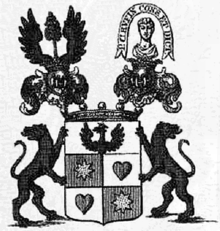Johann Baptist von Ruffini
Johann Baptist Reichsritter von Ruffini , originally Johann Baptist Ruffini zu Tiefenburg , (* 1672 in Meran ; † June 16, 1749 in Munich ) came from an old Tyrolean noble family with Italian roots who rose to become an important salt merchant in the Electorate of Bavaria .
Life
Ruffini came from Tirol vom Nonsberg . He moved to Bavaria between 1693 and 1695 and first settled in Diessen .
Memmingen was traditionally an important station for the salt trade, the city of Memmingen from Bavaria to Swabia and Switzerland . In 1706 the imperial administration in Bavaria intervened, two years later the partnership on the Bavarian side was taken over by Johann Baptist Ruffini, Munich bailiff, who was joined by the Augsburg merchant and banker Johann Thomas von Rauner the Elder (1659–1735) in the same year whose position from 1720 was followed by his son and son-in-law, Johann Thomas von Rauner the Younger (1689–1728), and son-in-law Christian Münch (1690–1757). In 1713 both had salt warehouses in Memmingen , Lindau and Kempten (Allgäu) . The city of Landsberg am Lech was supposed to buy 80,000 barrels of salt worth 960,000 florins from them within four years .
As a result, he advanced to the Bavarian Court Chamber Council in Munich and the Imperial Real Council and obtained the Bavarian noblemen's freedom. He was the only Munich resident who profited from the salt monopoly and with the fortune he had acquired acquired the Weyhern , Eisolzried with the castle, Nannhofen , Pelkovenschlössl and Planegg and made several foundations. In 1720 he was raised to the rank of imperial knight in Vienna .
Thanks to a generous donation from the court chamberat and banker, a new Sebastian altar was ordered from Egid Quirin Asam (1692–1750) for the Fürstenfeld monastery on January 6, 1737 .
The Ruffinihaus at Rindermarkt No. 12 in Munich , which he acquired in 1708, still reminds of Ruffini . Today the city's tourist office is located there. There are traditional Munich shops on the ground floor. His gravestone can be seen on the outer wall of Munich's Peterskirche .
family
Ruffini married Agnes, daughter of Carl Albert von Vacchiery, royal real secret councilor and court court chancellor († 1808). This marriage came from Franz Xaver Florian († 1815), nachheriger kurbayerischer chamberlain and privy councilor , who with a diploma from August 7, 1769 in the realm baron was charged.
Johann Baptist was married to Maria Johanna (1689–1768), a sister of the Secret Council Chancellor and Conference Minister Franz Xaver Josef Freiherr von Unertl and niece of the Traunstein salt administrator Johann Zacharias von Mezger, Edler von Meggenhoven.
His son-in-law was the Bavarian Real Secret Council , Lieutenant General Field Marshal and Court War Council director Jean-Gaspard, Count Basselet von La Rosée , and his grandson was the President of the Higher Appeal Court, Aloys Count Basselet von La Rosée .
The surname Rufin or Ruffin is occasionally used in the literature.
literature
- Gothaisches genealogical pocket book of baronial houses , Verlag Justus Perthes , Gotha 1856
- Ernst Heinrich Kneschke : New general German nobility lexicon . , Volume 7, Verlag Friedrich Voigt's Buchhandlung, Leipzig 1867
- Helga Hoffmann: "Up in the Allgäu, where bread has an end ': on the cultural history of a region", Volume 14, Verlag Zweckverband Schwäbisches Bauernhofmuseum, Illerbeuren 2000, ISBN 3931915034 , ISBN 9783931915032
- Philipp Schönborn: "Kloster Fürstenfeld", J. Fink, Ostfildern 2006, ISBN 9783898703246
Individual evidence
- ^ A b Ernst Heinrich Kneschke : New General German Adels Lexicon , Volume 7, Verlag Friedrich Voigt's Buchhandlung, Leipzig 1867, p. 621
- ↑ Stadtarchiv Esslingen, Working Group for Imperial City Historical Research, Monument Preservation and Civic Education: Yearbook for the History of the Upper German Imperial Cities , Volumes 11-13, Verlag Stadtarchiv, Esslingen 1965, p. 151
- ^ Rudolf Vierhaus: "Deutsche biographische Enzyklopädie (DBE)", p. 209
- ^ Wolfgang Zorn: Trade and Industrial History of Bavarian Swabia. 1648-1870 . In: Economic, social and cultural history of Swabian entrepreneurship. Publications of the Swabian Research Foundation at the Commission for Bavarian State History. Studies on the history of Bavarian Swabia . tape 6 . Verlag der Schwäbische Forschungsgemeinschaft, Augsburg 1961, p. 32 .
- ^ Helga Hoffmann: Droben im Allgäu, where bread has an end ': on the cultural history of a region , Volume 14, Verlag Zweckverband Schwäbisches Bauernhofmuseum, Illerbeuren 2000, p. 148
- ^ Philipp Schönborn: "Kloster Fürstenfeld", J. Fink, Ostfildern 2006 p. 120
- ↑ Gothaisches genealogical pocket book of baronial houses , Verlag Justus Perthes , Gotha 1856, p. 568ff.
- ^ Zech, Johann Nepomuk Felix von: Zech, Johann Nepomuk Felix von: Advertisement of the monasteries, counts and lordships in the Electorate of Bavaria ... [1]
| personal data | |
|---|---|
| SURNAME | Ruffini, Johann Baptist von |
| ALTERNATIVE NAMES | Johann Baptist Reichsritter von Ruffini (full name) |
| BRIEF DESCRIPTION | Salt merchant in Bavaria |
| DATE OF BIRTH | 1672 |
| PLACE OF BIRTH | Meran |
| DATE OF DEATH | June 16, 1749 |
| Place of death | Munich |


